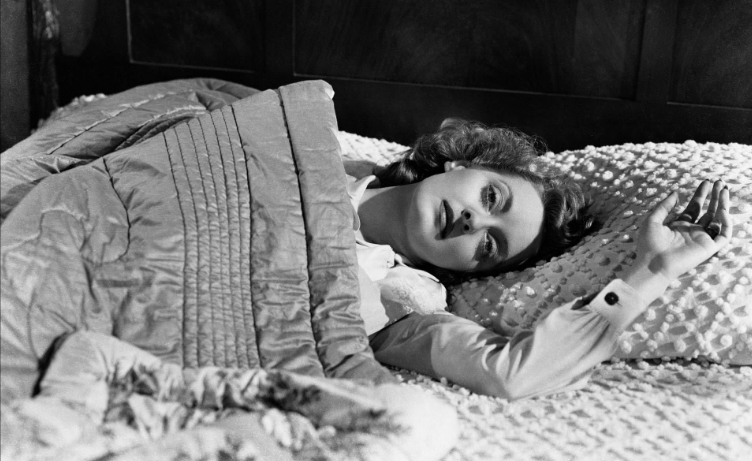 |
| Bette Davis in the memorable finale of Warner Brothers’ “Dark Victory,” from 1939. |
For Bette Davis and
Hollywood, 1939 was their zenith year.
Bette finally started to get
consistently better roles two years before, after her famed Warner
Brothers lawsuit. In 1939, Davis appeared in Dark Victory, Juarez, The Old Maid, and The Private Lives of Elizabeth and Essex.
 |
| My post on “Dark Victory” is part of the CMBA “Cry Me a River: Tearjerkers Blogathon.” Mine is on the first day, May 12, here: |
As for WB and the rest
of the studios, 1939 was considered the golden year of the studio era system.
The Oscar nominee categories overflowed with classic candidates. And the studio
system flourished through the WWII era. 1946 was Hollywood’s biggest year in
movie attendance, when the war was over. Davis’ biggest commercial hit, A Stolen Life, was released by WB that
watershed year.
 |
| Bette Davis is the heiress & George Brent is her doctor in 1939’s “Dark Victory.” |
Dark Victory was taken from an unsuccessful play, so WB’s top screenwriter,
Casey Robinson, used it as a starting point to whip up a classic confection of
cinematic romance. Much like Davis’ later Now,
Voyager, Robinson wrote a romantic yet grownup screenplay for Bette Davis.
 |
| The three stars of 1939’s “Dark Victory”: Geraldine Fitzgerald, George Brent, and the top star, Bette Davis, as Judith Traherne. |
The WB star was 30
when Dark Victory was filmed. For
once, Bette wasn’t playing older or nasty and her character, Judith Traherne,
is just 23. Dark Victory’s story is
quite simple, really. Judith finds out that she is seriously ill. At first, the
full prognosis is kept from her, but she finds out anyway. Upset at first, she
comes to accept her fate with grace, and embrace the time she has left. This
basic premise worked well again over 40 years later with Love Story. The major difference was the man and woman’s wealth
status were swapped.
 |
| Bette Davis is mercurial rich girl Judith Traherne in 1939’s “Dark Victory.” |
Though Bette Davis is
one of my favorites, I’ve never seen Dark
Victory until 2025. Why? I don’t enjoy movies where the main character is
dying. I’ve only seen clips of Love Story and have never watched Terms of Endearment all the way through.
I especially like how
Davis’ whirlwind of an heiress is portrayed. A character staple in screwball
comedies, they were often taken down a peg by the leading man, like a screwball
version of The Taming of the Shrew.
In Dark Victory, the good doctor does
his professional and personal best by Judith, with patience and love. It’s this
more modern approach that makes Dark
Victory so appealing.
Director Edmund
Goulding uses Bette Davis’ jittery intensity well for the scenes where she
initially diagnosed and later, when she finds out the tumor is terminal. And it
makes her more subdued scenes of happiness in life and later acceptance of her
plight so refreshing to watch.
Now a full-fledged
star, Bette Davis could dictate her own hair and makeup. Davis looked
magnificent as the headstrong heiress. Her favorite designer, Orry-Kelly,
created a wardrobe that was both realistic and glamorous—yet in character. When
Judith is settled at her country home, Davis sports simple sweaters, skirts,
and flats. Bette looks timeless in her casual wear. When she gets to dress up,
Davis looks divine, especially as photographed by Ernest Haller, her favorite
cinematographer. If this film had been made at MGM with Norma Shearer, it would
have been over the top luxury every step of the way. I always appreciated WB’s
more realistic approach to glamour. Also, Max Steiner composed a beautiful
score that was popular and Oscar-nominated.
 |
| Bette Davis & George Brent’s fateful newlyweds in 1939’s “Dark Victory.” |
What really surprised
me was how warm and gentle George Brent was as Dr. Frederick Steele, who
becomes devoted to Davis’ society girl. His quiet strength is a good contrast
to Davis’ headstrong Judith. He and Davis have a great rapport, which benefited
from their off-screen attraction. They made 11 films together and later
reunited in The Great Lie with Dark Victory director Edmund Goulding. Also,
George Brent is at the peak of his matinee idol looks here, too!
 |
| George Brent is the empathetic Dr. Frederick Steele in 1939’s “Dark Victory.” |
Geraldine Fitzgerald
is Ann, Judith’s secretary and best friend. Fitzgerald is very naturalistic in
look and manner, so she seems quite contemporary. Her Ann is sensible to
Judith’s mercurial personality. Fitzgerald and Davis have a natural rapport and
became friendly off-camera, too. And Gerry was Oscar-nominated the same year
for supporting actress, as Isabella in Wuthering
Heights. Fitzgerald made the two films back to back and they were released
the spring of 1939.
 |
| Geraldine Fitzgerald is Ann, the secretary & best friend of Bette Davis’ horse-loving heiress in 1939’s “Dark Victory.” |
Humphrey Bogart and
Ronald Reagan are iconic names today. Back in 1939, they were up and coming
names, who came into their own in the early ’40s. Thankfully, their roles in Dark Victory don’t weigh heavily on the
story, because they’re both rather bad in this otherwise well-acted movie, for
different reasons. Bogie plays the Irish horse trainer with an obvious accent. His
character feels barely sketched out. As the cocky stable hand who yearns for
the impetuous rich girl, he was no Heathcliff from that year’s Wuthering Heights! Ronald Reagan plays
Bette’s drinking buddy/maybe boy toy, with little depth at all. Ronnie’s attempts
at playing a Gig Young-type charmer who drinks are amateurish.
 |
| Humphrey Bogart as the Irish horse trainer to Bette Davis’ spirited heiress doesn’t exactly inspire comparisons to “Wuthering Heights!” “Dark Victory” from 1939. |
Edmund Goulding’s
direction is understated and grownup, so the sentiment is not over the top. Goulding
handled challenging material like Dark
Victory, Grand Hotel, The Razor’s
Edge, and Nightmare Alley quite
well.
 |
| Bette Davis’ Judith Traherne with one of her playmates, mildly played by Ronald Reagan, in 1939’s “Dark Victory.” |
The Dark Victory finale is genuinely
touching and subtly done, when Bette’s young wife sends her husband off, and then
her best friend. Judith says goodbye to her dogs, then after the maid helps her
upstairs and into bed, she asks to be left alone. Her vision quickly fading,
she goes to sleep, as the camera goes out of focus and Max Steiner’s score
swells. Major tearjerker alert!
As often the case when
the studio glory days were on the wane, they often did color remakes of the
‘30s and ‘40s classics. Susan Hayward starred as the Dark Victory heiress in 1963’s Stolen
Hours, filmed in England, with British co-star Michael Craig. It’s watchable
and Susan is sincere as the heiress. Stolen
Hours was not a hit. Perhaps because Susan was trying to play younger, as
kid sister Diane Baker was over 20 years younger, and leading man Craig was a
dozen years junior. Susan is beautifully photographed and looked far better
than contemporaries Vivien Leigh and Lana Turner during this period. But she
didn’t look like a young woman who’s cheated out of life, so Stolen Hours looked like a stodgy rehash.
 |
| Susan Hayward’s remake, “Stolen Hours,” from 1963. |
The failure of the ’63
Dark Victory remake might have
signaled that such a soapy story was old news. In 1970, this was proved
otherwise, offering hip young couple Ryan O’Neal and Ali MacGraw, very
contemporary in an otherwise old-fashioned Love
Story, a box office smash.
 |
| “Love Story” from 1970 proved there’s nothing new under the sun! |
And while I adore
Elizabeth Montgomery, I have no desire to watch the 1976 TV remake that’s 2 and
½ hours long! Even with Anthony Hopkins as the doc and Michele Lee as the best
friend, that’s too much, as both earlier versions were about 1 and ¾ hours
longs—plenty on both counts.
 |
| Anthony Hopkins & Elizabeth Montgomery are fine actors, but a 2.5 hour version of “Dark Victory?!” |
The message of Dark Victory is timeless, that it’s more
important how much you are living your life, not how long you are going to
live. And that message is a positive prognosis of life!
 |
| The tear-jerking scene when Judith realizes her vision is going, signaling her impending death, in 1939’s “Dark Victory.”W/ Geraldine Fitzgerald & Bette Davis. |
Here’s my take on
Bette Davis’ other great romantic role, as Charlotte Vale in 1942’s Now, Voyager:
https://ricksrealreel.blogspot.com/2018/02/now-voyager-1942.html
 |
| Bette Davis with Paul Henreid, in “Now, Voyager.” |








